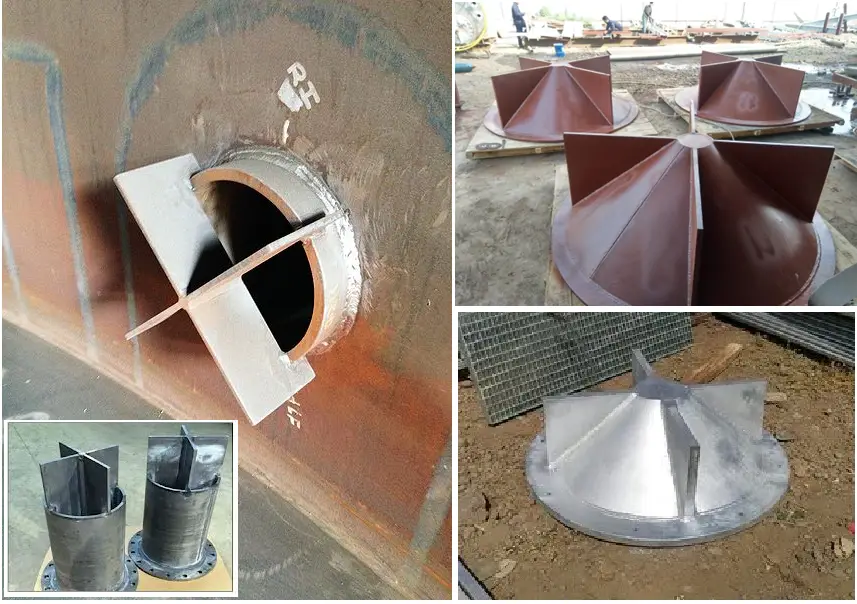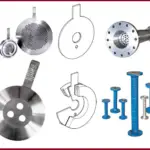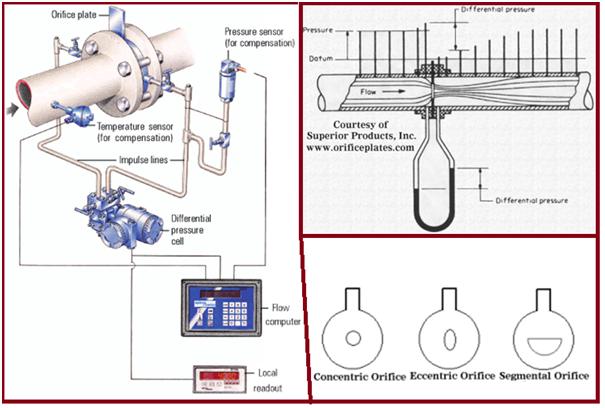A vortex breaker is a device that is used to prevent the formation of vortices, or swirling patterns of fluid flow, in equipment or piping system. Vortexes can occur when fluid flows through a bend or restriction in the vessel or pipe and can cause problems such as increased turbulence, reduced flow efficiency, and increased wear and tear on the pipes and other components.
A vortex breaker is typically a small, cylindrical, triangular-shaped, or cross-shaped device that is installed in the vessel/pipe at the location where the vortex is likely to form. The device creates a disturbance in the fluid flow that breaks up the vortex before it can form, thus preventing the problems caused by vortexes. Vortex breakers are commonly used in applications such as industrial cooling systems, process control systems, and oil and gas production.
They can be installed either inside or outside the vessel/pipe, in vertical or horizontal positions, and their design depends on the fluid properties, flow rate, and pipe size.
Effect of Vortices on Flow
The main reasons behind avoiding a vortex formation are
- They create an obstruction in the smooth flow.
- Vortex flow draws down gases inside it and creates a two-phase flow which has several drawbacks.
- Vortices disrupt the flow pattern inside the pipe or nozzle and can create erosion of pipes and fittings.
- The occurrence of a vortex in a fluid system leads to a reduction of pressure. So, the requirement of pumping force increases.
Applications of a Vortex Breaker
Vortex breakers are commonly used in a variety of industrial and commercial applications where fluid flow through a piping system is involved. Some of the most common applications of vortex breakers include:
Industrial cooling systems: Vortex breakers are often used in industrial cooling systems to prevent the formation of vortices in the cooling water, which can reduce the efficiency of the system and cause damage to the pipes and other components.
Process control systems: Vortex breakers are used in process control systems to prevent the formation of vortices in fluids such as chemicals, oil, and gas, which can interfere with the accuracy of flow measurement and control.
Oil and gas production: Vortex breakers are used in oil and gas production to prevent the formation of vortices in the production fluids, which can cause problems such as decreased production rates, increased wear and tear on the equipment, and increased safety risks.
Water treatment systems: Vortex breakers are used in water treatment systems, such as in the intake of water from rivers or lakes, where they prevent the formation of vortices that can lead to the entrainment of debris or aquatic life.
Fire-protection systems: In fire-protection systems, vortex breakers are used to prevent the formation of vortices in the water supply, which can interfere with the flow of water to the fire hose, reducing the effectiveness of the system.
HVAC systems: Vortex breakers are used in HVAC systems to prevent the formation of vortices in the airflow, which can reduce the efficiency of the system and cause damage to the ducts and other components.
The use of vortex breakers can improve the efficiency and performance of the system, reduce maintenance costs, and improve safety and reliability.
Design of a Vortex Breaker
Designing a vortex breaker involves several steps:
- Identify the fluid that will be flowing through the pipe and its properties, including viscosity, density, and flow rate.
- Determine the location where the vortex is likely to form, and the pipe size and configuration at that point.
- Select the appropriate materials for the vortex breaker, taking into consideration factors such as corrosion resistance, pressure and temperature ratings, and compatibility with the fluid.
- Determine the appropriate size and shape of the vortex breaker based on the fluid properties, pipe size, and flow rate.
- Choose the type of vortex breaker that will be used, such as a cylindrical or triangular shape.
- Create a detailed layout and drawing of the vortex breaker, including the location, size, and shape.
- Consider the safety and maintenance aspects, ensuring that the vortex breaker is designed to be easily accessible for maintenance and repair.
- Conduct a simulation of the flow, including computational fluid dynamics (CFD) analysis, to verify the design and identify any potential issues.
- Consult with the appropriate professionals, such as engineers or fluid dynamics experts, and comply with any relevant industry standards or codes.
Keep in mind that the design of a vortex breaker depends on the specific application, the fluid properties, and the pipe size and configuration, so it’s essential to consider these factors when designing a vortex breaker.
Working of a Vortex Breaker
A vortex breaker works by disrupting the flow of fluid and preventing the formation of vortices, or swirling patterns of fluid flow, in a piping system.
Vortexes can occur in a piping system when fluid flows through a bend or restriction in the pipe, such as an elbow or valve. As the fluid flows through the bend, it creates a swirling pattern, or vortex, that can cause problems such as increased turbulence, reduced flow efficiency, and increased wear and tear on the pipes and other components.
When the fluid flows into the vortex breaker, it is forced to flow around it and the vortex breaker creates a separation in the flow, breaking the vortex and preventing it from forming. The vortex breaker also helps to increase the flow efficiency, reducing the pressure drop, and improving the performance of the system.
It’s important to note that the design and the position of the vortex breaker are critical in order to achieve the desired results. The fluid properties, the flow rate, and the pipe size must be taken into account when designing the vortex breaker.

Types of Vortex Breakers
There are several major types of vortex breakers, each with its own unique features and applications. Some of the most common types include:
Cylindrical vortex breaker: A cylindrical vortex breaker is a small cylindrical device that is installed in the pipe to prevent the formation of vortices. It is typically made of metal or plastic, and it’s placed in a perpendicular position to the fluid flow. It’s commonly used in industrial cooling systems and process control systems.
Triangular vortex breaker: A triangular vortex breaker is similar to a cylindrical vortex breaker, but it has a triangular shape. It’s also placed in a perpendicular position to the fluid flow. It’s commonly used in oil and gas production, and water treatment systems.
Plate vortex breaker (Disc or Cross type): A plate vortex breaker is a flat plate that is installed in the pipe to prevent the formation of vortices. It’s typically installed in a vertical or horizontal position, and it’s commonly used in HVAC systems, fire-protection systems, and process control systems.
Spike vortex breaker: A spike vortex breaker is a small device that has a spike-like shape. It’s typically installed in a vertical position, and it’s commonly used in industrial cooling systems and process control systems.
Spiral vortex breaker: A spiral vortex breaker is a small device that has a spiral shape. It’s typically installed in a vertical position and it’s commonly used in oil and gas production and process control systems.
It’s worth noting that the choice of vortex breaker depends on the specific application, the fluid properties, and the pipe size and configuration. Additionally, the design and the position of the vortex breaker are critical in order to achieve the desired results, so it’s essential to consult with experts and comply with industry standards or codes.
Vortex Breaker Manufacturers
There are several reputed manufacturers of vortex breakers, including:
Spirax Sarco: Spirax Sarco is a well-known manufacturer of vortex breakers and other flow control products. They offer a wide range of vortex breakers for various industries and applications.
Fluid Components International (FCI): FCI is a leading manufacturer of vortex breakers and other flow measurement and control products. They offer a wide range of vortex breakers for various industries and applications.
Vortab: Vortab is a manufacturer of vortex breakers and other flow control products. They offer a wide range of vortex breakers for various industries and applications.
Vortex Flow Control: Vortex Flow Control is a manufacturer of vortex breakers and other flow control products. They offer a wide range of vortex breakers for various industries and applications.
Pro Flow Dynamics: Pro Flow Dynamics is a manufacturer of vortex breakers and other flow control products. They offer a wide range of vortex breakers for various industries and applications.
Badger Meter: Badger Meter is a manufacturer of vortex breakers and other flow measurement and control products. They offer a wide range of vortex breakers for various industries and applications.
Flow-Tech Industries: Flow-Tech Industries is a manufacturer of vortex breakers and other flow control products. They offer a wide range of vortex breakers for various industries and applications.
This list is not exhaustive and there are many other manufacturers of vortex breakers. It’s important to research different manufacturers and products before making a purchase to ensure that the vortex breaker is suitable for the specific application and that the manufacturer has a good reputation for quality and reliability.
Vortex Breaker in Tanks
A vortex breaker in tanks refers to a device or structure that is designed to prevent the formation of vortices or swirling patterns of fluid flow within a tank. These vortices can occur when fluid is being pumped into or out of a tank, or when the fluid level in the tank is changing.
The vortices can cause problems such as increased turbulence, reduced flow efficiency, and increased wear and tear on the tank and its components. The vortex breaker is typically installed at the inlet or outlet of the tank, or at the surface of the fluid within the tank.
Vortex breakers in tanks can be of different types and designs depending on the application and the fluid properties. Some common types of vortex breakers in tanks include:
Roof-mounted vortex breaker: A roof-mounted vortex breaker is a device that is installed on the roof of a tank to prevent the formation of vortices at the surface of the fluid. It’s commonly used in oil and gas storage tanks.
Surface-mounted vortex breaker: A surface-mounted vortex breaker is a device that is installed at the surface of the fluid in a tank to prevent the formation of vortices. It’s commonly used in industrial cooling systems, and process control systems.
Inlet-mounted vortex breaker: An inlet-mounted vortex breaker is a device that is installed at the inlet of a tank to prevent the formation of vortices when fluid is being pumped into the tank. It’s commonly used in water treatment systems and fire-protection systems.
Outlet-mounted vortex breaker: An outlet-mounted vortex breaker is a device that is installed at the outlet of a tank to prevent the formation of vortices when fluid is being pumped out of the tank. It’s commonly used in industrial cooling systems, and process control systems.
Vortex breakers in tanks are designed to improve the efficiency and performance of the system, reduce maintenance costs, and improve safety and reliability. It’s important to consider the fluid properties, flow rate, and tank size and configuration when designing the vortex breaker for the tank.
Vortex Breaker in Pump Suction
A vortex breaker in pump suction refers to a device or structure that is designed to prevent the formation of vortices, or swirling patterns of fluid flow, in the suction line of a pump. Vortexes can occur in the suction line of a pump when the fluid is being drawn into the pump and can cause problems such as reduced flow efficiency, cavitation, and increased wear and tear on the pump and its components.
A vortex breaker in pump suction is typically a small, cylindrical, or triangular-shaped device that is installed in the suction line near the pump. The device creates a disturbance in the fluid flow that breaks up the vortex before it can form, thus preventing the problems caused by vortexes. The disturbance is created by the shape and the position of the vortex breaker in the pipe.
The use of a vortex breaker in pump suction can improve the efficiency and performance of the system, reduce maintenance costs, and improve safety and reliability. It’s important to consider the fluid properties, flow rate, and suction pipe size and configuration when designing the vortex breaker for the pump suction.









I am piping engineer in reputed company.
I like your blogs and following you from 27-3-23 , means from yesterday.
I want to be in touch with you.
how to find pressure drop across cross-type vortex breaker for storage tank
Do you have any manufacturer’s contacts who can design and supply vortex breakers?